Wind Energy: Alternative Energy Source for Australia - Research Report
VerifiedAdded on 2023/06/11
|40
|10046
|282
Report
AI Summary
This research report investigates wind energy as an alternative energy source for Australia, addressing the increasing demand for electricity and the need for environmentally friendly renewable sources. It highlights the limitations of hydroelectric power due to water scarcity and the rapid growth of wind power in various regions. The report discusses factors affecting wind power output, including rotor area, wind velocity, and air density, and examines existing wind farms and energy storage solutions in Australia. It also contrasts the advantages and disadvantages of wind energy compared to non-renewable sources, emphasizing the importance of reducing carbon dioxide emissions and achieving renewable energy targets. The paper concludes by considering the future prospects of wind energy in Australia and advocating for its role in solving the energy crisis and promoting sustainable electricity generation. Desklib provides access to this and other solved assignments.

Wind Energy 1
WIND ENERGY AS AN ALTERNATIVE ENERGY SOURCE FOR AUSTRALIA
A Research Paper on Energy By
Student’s Name
Name of the Professor
Institutional Affiliation
City/State
Year/Month/Day
WIND ENERGY AS AN ALTERNATIVE ENERGY SOURCE FOR AUSTRALIA
A Research Paper on Energy By
Student’s Name
Name of the Professor
Institutional Affiliation
City/State
Year/Month/Day
Paraphrase This Document
Need a fresh take? Get an instant paraphrase of this document with our AI Paraphraser

Wind Energy 2
ABSTRACT
In order to generate sufficient electricity to satisfy the demand within the country, there is
need of increasing the generation but majorly focusing on the renewable sources which are
environmentally friendly. The selected renewable energy option for this research is the wind
energy source as an alternative source of electricity generation in Australia. The hydroelectric
capacity in the country is not fully deployed since the shortage of ground water in the country is
a primary constraint for the further establishment. The growth of wind power energy source is
rapidly increasing in numerous geographical locations within the country, this is the major
reason for selecting the wind energy as an alternative energy source for Australia for this
research.
There have been numerous steps put in place to reduce the emission of carbon dioxide in
the country such as in 2012, there was the establishment of the carbon tax and carbon price so as
to make it more practical for the companies to minimize their emission of carbon dioxide. Some
of the factors that affect the output of wind power generated in Australia include rotor area, wind
velocity, air density, rotation of the earth, the heat from the sun, the cooling effect of the polar
ice caps and oceans, temperature gradient between sea and land, and the physical effects of the
mountains and other obstacles
ABSTRACT
In order to generate sufficient electricity to satisfy the demand within the country, there is
need of increasing the generation but majorly focusing on the renewable sources which are
environmentally friendly. The selected renewable energy option for this research is the wind
energy source as an alternative source of electricity generation in Australia. The hydroelectric
capacity in the country is not fully deployed since the shortage of ground water in the country is
a primary constraint for the further establishment. The growth of wind power energy source is
rapidly increasing in numerous geographical locations within the country, this is the major
reason for selecting the wind energy as an alternative energy source for Australia for this
research.
There have been numerous steps put in place to reduce the emission of carbon dioxide in
the country such as in 2012, there was the establishment of the carbon tax and carbon price so as
to make it more practical for the companies to minimize their emission of carbon dioxide. Some
of the factors that affect the output of wind power generated in Australia include rotor area, wind
velocity, air density, rotation of the earth, the heat from the sun, the cooling effect of the polar
ice caps and oceans, temperature gradient between sea and land, and the physical effects of the
mountains and other obstacles

Wind Energy 3
ACKNOWLEDGEMENT
I would wish to sincerely thank the important departments and organizations that assisted me
with numerous information which was used in compiling this research paper. These departments
include Transport and Regional Economics, the Bureau of Infrastructure, the Australian Bureau
of Statistics, the Clean Energy Regulator, Department of Environment, Geoscience Australia,
and Innovation and Science.
ACKNOWLEDGEMENT
I would wish to sincerely thank the important departments and organizations that assisted me
with numerous information which was used in compiling this research paper. These departments
include Transport and Regional Economics, the Bureau of Infrastructure, the Australian Bureau
of Statistics, the Clean Energy Regulator, Department of Environment, Geoscience Australia,
and Innovation and Science.
⊘ This is a preview!⊘
Do you want full access?
Subscribe today to unlock all pages.

Trusted by 1+ million students worldwide
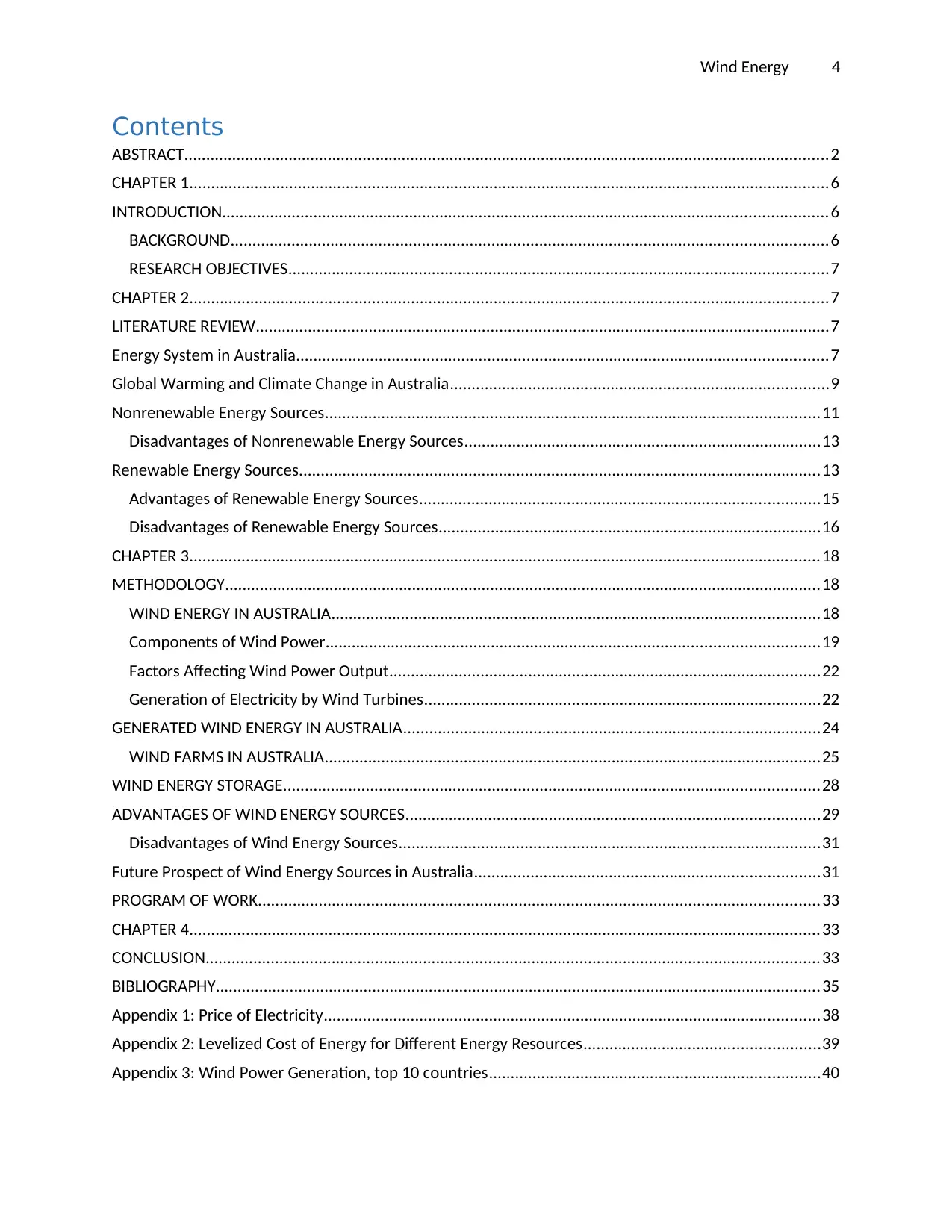
Wind Energy 4
Contents
ABSTRACT....................................................................................................................................................2
CHAPTER 1...................................................................................................................................................6
INTRODUCTION...........................................................................................................................................6
BACKGROUND.........................................................................................................................................6
RESEARCH OBJECTIVES............................................................................................................................7
CHAPTER 2...................................................................................................................................................7
LITERATURE REVIEW....................................................................................................................................7
Energy System in Australia..........................................................................................................................7
Global Warming and Climate Change in Australia.......................................................................................9
Nonrenewable Energy Sources..................................................................................................................11
Disadvantages of Nonrenewable Energy Sources..................................................................................13
Renewable Energy Sources........................................................................................................................13
Advantages of Renewable Energy Sources............................................................................................15
Disadvantages of Renewable Energy Sources........................................................................................16
CHAPTER 3.................................................................................................................................................18
METHODOLOGY.........................................................................................................................................18
WIND ENERGY IN AUSTRALIA................................................................................................................18
Components of Wind Power.................................................................................................................19
Factors Affecting Wind Power Output...................................................................................................22
Generation of Electricity by Wind Turbines...........................................................................................22
GENERATED WIND ENERGY IN AUSTRALIA................................................................................................24
WIND FARMS IN AUSTRALIA..................................................................................................................25
WIND ENERGY STORAGE...........................................................................................................................28
ADVANTAGES OF WIND ENERGY SOURCES...............................................................................................29
Disadvantages of Wind Energy Sources.................................................................................................31
Future Prospect of Wind Energy Sources in Australia...............................................................................31
PROGRAM OF WORK.................................................................................................................................33
CHAPTER 4.................................................................................................................................................33
CONCLUSION.............................................................................................................................................33
BIBLIOGRAPHY...........................................................................................................................................35
Appendix 1: Price of Electricity..................................................................................................................38
Appendix 2: Levelized Cost of Energy for Different Energy Resources......................................................39
Appendix 3: Wind Power Generation, top 10 countries............................................................................40
Contents
ABSTRACT....................................................................................................................................................2
CHAPTER 1...................................................................................................................................................6
INTRODUCTION...........................................................................................................................................6
BACKGROUND.........................................................................................................................................6
RESEARCH OBJECTIVES............................................................................................................................7
CHAPTER 2...................................................................................................................................................7
LITERATURE REVIEW....................................................................................................................................7
Energy System in Australia..........................................................................................................................7
Global Warming and Climate Change in Australia.......................................................................................9
Nonrenewable Energy Sources..................................................................................................................11
Disadvantages of Nonrenewable Energy Sources..................................................................................13
Renewable Energy Sources........................................................................................................................13
Advantages of Renewable Energy Sources............................................................................................15
Disadvantages of Renewable Energy Sources........................................................................................16
CHAPTER 3.................................................................................................................................................18
METHODOLOGY.........................................................................................................................................18
WIND ENERGY IN AUSTRALIA................................................................................................................18
Components of Wind Power.................................................................................................................19
Factors Affecting Wind Power Output...................................................................................................22
Generation of Electricity by Wind Turbines...........................................................................................22
GENERATED WIND ENERGY IN AUSTRALIA................................................................................................24
WIND FARMS IN AUSTRALIA..................................................................................................................25
WIND ENERGY STORAGE...........................................................................................................................28
ADVANTAGES OF WIND ENERGY SOURCES...............................................................................................29
Disadvantages of Wind Energy Sources.................................................................................................31
Future Prospect of Wind Energy Sources in Australia...............................................................................31
PROGRAM OF WORK.................................................................................................................................33
CHAPTER 4.................................................................................................................................................33
CONCLUSION.............................................................................................................................................33
BIBLIOGRAPHY...........................................................................................................................................35
Appendix 1: Price of Electricity..................................................................................................................38
Appendix 2: Levelized Cost of Energy for Different Energy Resources......................................................39
Appendix 3: Wind Power Generation, top 10 countries............................................................................40
Paraphrase This Document
Need a fresh take? Get an instant paraphrase of this document with our AI Paraphraser

Wind Energy 5
LIST OF FIGURES
Figure 1: Production and consumption of energy-mix in Australia …………………………… 8
Figure 2: Energy sources distribution in Australia …………………………………………….. 9
Figure 3: Emission of green gas in every sector in Australia ……………………………..….. 11
Figure 4: Electricity generation from renewable energy sources in Australia ……………...... 13
Figure 5: Schematics of a typical wind turbine ………………………………………….…… 21
Figure 6: Wind energy generation in Australia ………………………………………............ 24
Figure 7: Wind generation, wind penetration, rooftop PV, and demand in South Australia….26
Figure 8: Wind Energy installed capacity by Australian states ………………………….…...28
Figure 9: Lithium-ion battery system of wind power storage ………………………………...30
LIST OF FIGURES
Figure 1: Production and consumption of energy-mix in Australia …………………………… 8
Figure 2: Energy sources distribution in Australia …………………………………………….. 9
Figure 3: Emission of green gas in every sector in Australia ……………………………..….. 11
Figure 4: Electricity generation from renewable energy sources in Australia ……………...... 13
Figure 5: Schematics of a typical wind turbine ………………………………………….…… 21
Figure 6: Wind energy generation in Australia ………………………………………............ 24
Figure 7: Wind generation, wind penetration, rooftop PV, and demand in South Australia….26
Figure 8: Wind Energy installed capacity by Australian states ………………………….…...28
Figure 9: Lithium-ion battery system of wind power storage ………………………………...30
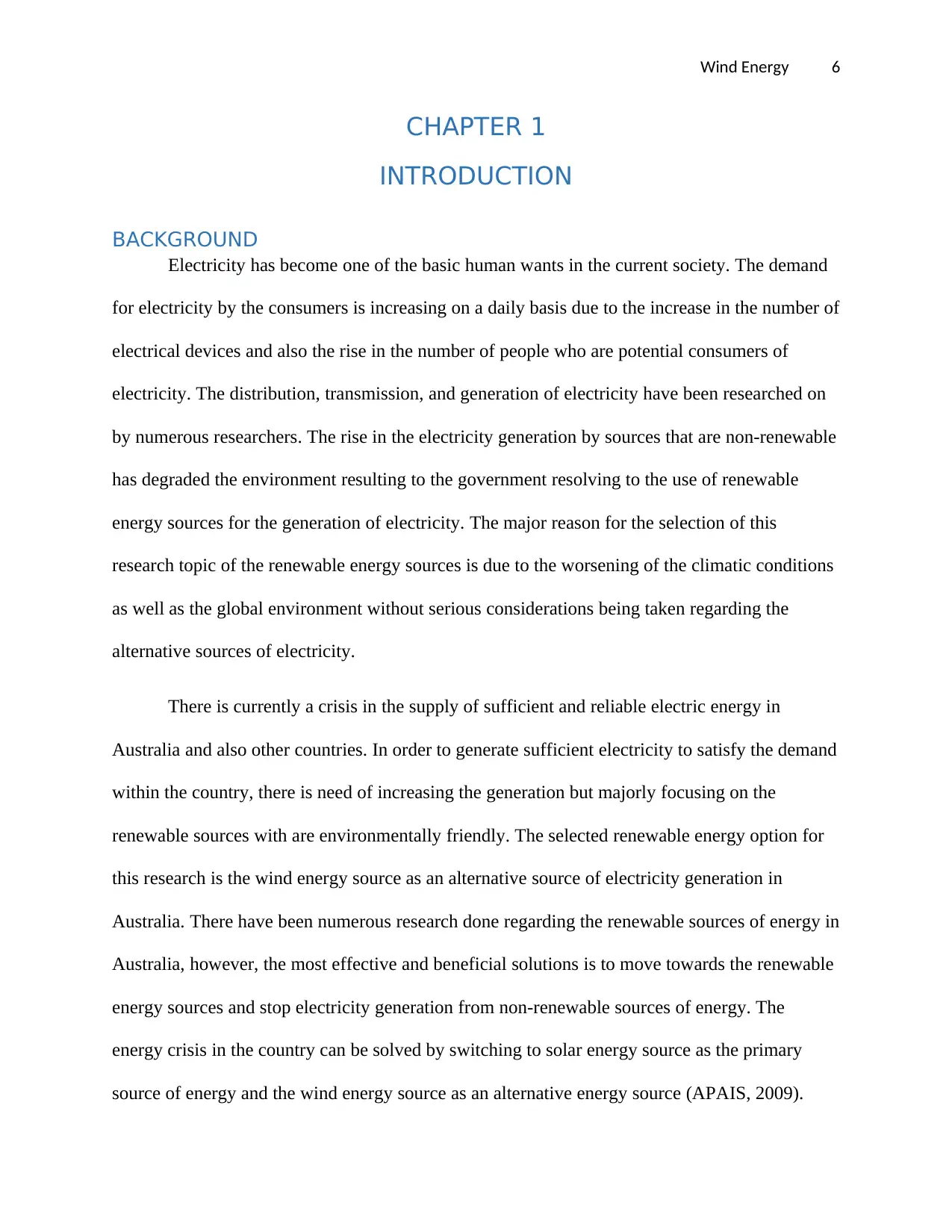
Wind Energy 6
CHAPTER 1
INTRODUCTION
BACKGROUND
Electricity has become one of the basic human wants in the current society. The demand
for electricity by the consumers is increasing on a daily basis due to the increase in the number of
electrical devices and also the rise in the number of people who are potential consumers of
electricity. The distribution, transmission, and generation of electricity have been researched on
by numerous researchers. The rise in the electricity generation by sources that are non-renewable
has degraded the environment resulting to the government resolving to the use of renewable
energy sources for the generation of electricity. The major reason for the selection of this
research topic of the renewable energy sources is due to the worsening of the climatic conditions
as well as the global environment without serious considerations being taken regarding the
alternative sources of electricity.
There is currently a crisis in the supply of sufficient and reliable electric energy in
Australia and also other countries. In order to generate sufficient electricity to satisfy the demand
within the country, there is need of increasing the generation but majorly focusing on the
renewable sources with are environmentally friendly. The selected renewable energy option for
this research is the wind energy source as an alternative source of electricity generation in
Australia. There have been numerous research done regarding the renewable sources of energy in
Australia, however, the most effective and beneficial solutions is to move towards the renewable
energy sources and stop electricity generation from non-renewable sources of energy. The
energy crisis in the country can be solved by switching to solar energy source as the primary
source of energy and the wind energy source as an alternative energy source (APAIS, 2009).
CHAPTER 1
INTRODUCTION
BACKGROUND
Electricity has become one of the basic human wants in the current society. The demand
for electricity by the consumers is increasing on a daily basis due to the increase in the number of
electrical devices and also the rise in the number of people who are potential consumers of
electricity. The distribution, transmission, and generation of electricity have been researched on
by numerous researchers. The rise in the electricity generation by sources that are non-renewable
has degraded the environment resulting to the government resolving to the use of renewable
energy sources for the generation of electricity. The major reason for the selection of this
research topic of the renewable energy sources is due to the worsening of the climatic conditions
as well as the global environment without serious considerations being taken regarding the
alternative sources of electricity.
There is currently a crisis in the supply of sufficient and reliable electric energy in
Australia and also other countries. In order to generate sufficient electricity to satisfy the demand
within the country, there is need of increasing the generation but majorly focusing on the
renewable sources with are environmentally friendly. The selected renewable energy option for
this research is the wind energy source as an alternative source of electricity generation in
Australia. There have been numerous research done regarding the renewable sources of energy in
Australia, however, the most effective and beneficial solutions is to move towards the renewable
energy sources and stop electricity generation from non-renewable sources of energy. The
energy crisis in the country can be solved by switching to solar energy source as the primary
source of energy and the wind energy source as an alternative energy source (APAIS, 2009).
⊘ This is a preview!⊘
Do you want full access?
Subscribe today to unlock all pages.

Trusted by 1+ million students worldwide
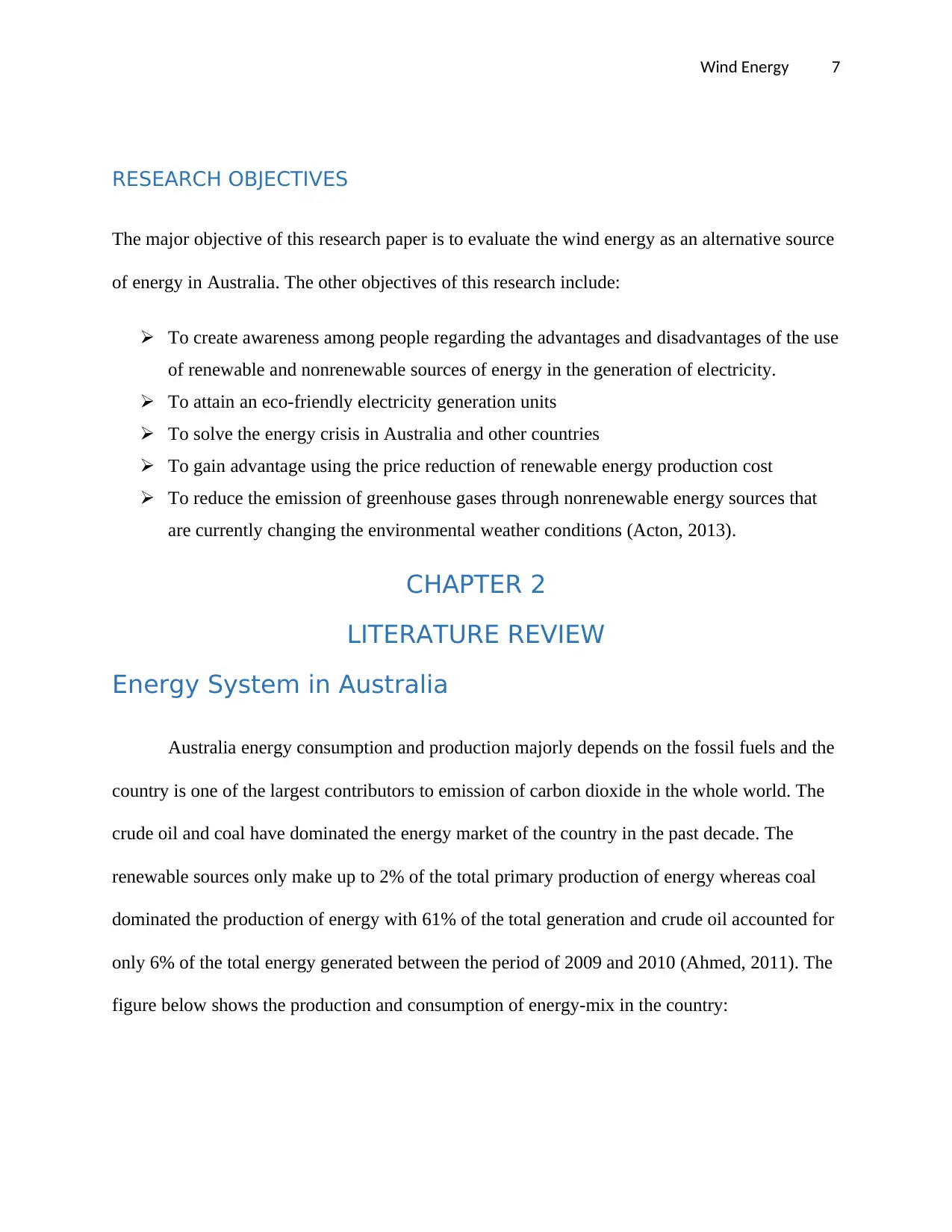
Wind Energy 7
RESEARCH OBJECTIVES
The major objective of this research paper is to evaluate the wind energy as an alternative source
of energy in Australia. The other objectives of this research include:
To create awareness among people regarding the advantages and disadvantages of the use
of renewable and nonrenewable sources of energy in the generation of electricity.
To attain an eco-friendly electricity generation units
To solve the energy crisis in Australia and other countries
To gain advantage using the price reduction of renewable energy production cost
To reduce the emission of greenhouse gases through nonrenewable energy sources that
are currently changing the environmental weather conditions (Acton, 2013).
CHAPTER 2
LITERATURE REVIEW
Energy System in Australia
Australia energy consumption and production majorly depends on the fossil fuels and the
country is one of the largest contributors to emission of carbon dioxide in the whole world. The
crude oil and coal have dominated the energy market of the country in the past decade. The
renewable sources only make up to 2% of the total primary production of energy whereas coal
dominated the production of energy with 61% of the total generation and crude oil accounted for
only 6% of the total energy generated between the period of 2009 and 2010 (Ahmed, 2011). The
figure below shows the production and consumption of energy-mix in the country:
RESEARCH OBJECTIVES
The major objective of this research paper is to evaluate the wind energy as an alternative source
of energy in Australia. The other objectives of this research include:
To create awareness among people regarding the advantages and disadvantages of the use
of renewable and nonrenewable sources of energy in the generation of electricity.
To attain an eco-friendly electricity generation units
To solve the energy crisis in Australia and other countries
To gain advantage using the price reduction of renewable energy production cost
To reduce the emission of greenhouse gases through nonrenewable energy sources that
are currently changing the environmental weather conditions (Acton, 2013).
CHAPTER 2
LITERATURE REVIEW
Energy System in Australia
Australia energy consumption and production majorly depends on the fossil fuels and the
country is one of the largest contributors to emission of carbon dioxide in the whole world. The
crude oil and coal have dominated the energy market of the country in the past decade. The
renewable sources only make up to 2% of the total primary production of energy whereas coal
dominated the production of energy with 61% of the total generation and crude oil accounted for
only 6% of the total energy generated between the period of 2009 and 2010 (Ahmed, 2011). The
figure below shows the production and consumption of energy-mix in the country:
Paraphrase This Document
Need a fresh take? Get an instant paraphrase of this document with our AI Paraphraser
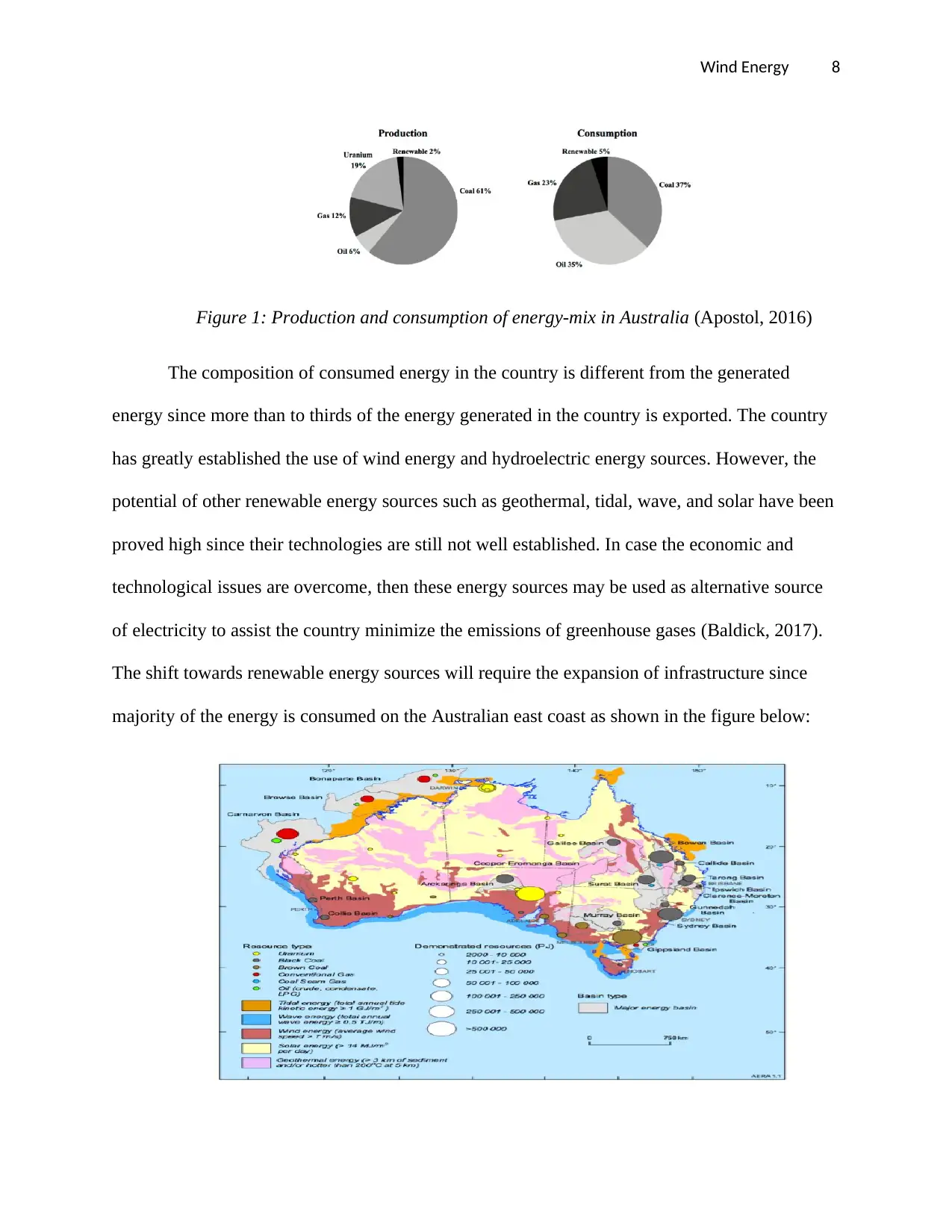
Wind Energy 8
Figure 1: Production and consumption of energy-mix in Australia (Apostol, 2016)
The composition of consumed energy in the country is different from the generated
energy since more than to thirds of the energy generated in the country is exported. The country
has greatly established the use of wind energy and hydroelectric energy sources. However, the
potential of other renewable energy sources such as geothermal, tidal, wave, and solar have been
proved high since their technologies are still not well established. In case the economic and
technological issues are overcome, then these energy sources may be used as alternative source
of electricity to assist the country minimize the emissions of greenhouse gases (Baldick, 2017).
The shift towards renewable energy sources will require the expansion of infrastructure since
majority of the energy is consumed on the Australian east coast as shown in the figure below:
Figure 1: Production and consumption of energy-mix in Australia (Apostol, 2016)
The composition of consumed energy in the country is different from the generated
energy since more than to thirds of the energy generated in the country is exported. The country
has greatly established the use of wind energy and hydroelectric energy sources. However, the
potential of other renewable energy sources such as geothermal, tidal, wave, and solar have been
proved high since their technologies are still not well established. In case the economic and
technological issues are overcome, then these energy sources may be used as alternative source
of electricity to assist the country minimize the emissions of greenhouse gases (Baldick, 2017).
The shift towards renewable energy sources will require the expansion of infrastructure since
majority of the energy is consumed on the Australian east coast as shown in the figure below:

Wind Energy 9
Figure 2: Energy sources distribution in Australia (Apostol, 2016)
A huge part of the renewable energy generation is based on the hydroelectric energy
source. However, the hydroelectric capacity in the country is not fully deployed since the
shortage of ground water in the country is a primary constraint for further establishment. The
growth of in wind power energy source is rapidly increasing in numerous geographical locations
within the country, this is the major reason for selection of wind energy as an alternative energy
source for Australia. From the figure above, it is clear that the wind power source has potential
along the southern coast and also the inland regions. Solar energy source has also potential in the
country since the radiation in majority of the state are considered among the highest level of
radiation globally (Boxwell, 2010).
Huge plants of solar power are still not fully developed and the energy sources are
currently used by the residential small-scale and off-grid installations. Tidal and wave energy
sources are still under the stage of research but are believed to the future energy sources for the
production of energy. Australia is one of the largest energy consumers globally and is ranked in
the 8th position in the worlds largest energy consumers. The rate of growth in energy
consumption has however slowed gradually in the past decade. This decline in the amount of
energy consumed in the country can be explained by the economic crises and oil price shocks
during the past few years. The demand for energy is expected to continue increasing and the
future distribution of these energy sources will be determined by numerous factors such as
energy price and government policies (Brewer, 2013).
Global Warming and Climate Change in Australia
Figure 2: Energy sources distribution in Australia (Apostol, 2016)
A huge part of the renewable energy generation is based on the hydroelectric energy
source. However, the hydroelectric capacity in the country is not fully deployed since the
shortage of ground water in the country is a primary constraint for further establishment. The
growth of in wind power energy source is rapidly increasing in numerous geographical locations
within the country, this is the major reason for selection of wind energy as an alternative energy
source for Australia. From the figure above, it is clear that the wind power source has potential
along the southern coast and also the inland regions. Solar energy source has also potential in the
country since the radiation in majority of the state are considered among the highest level of
radiation globally (Boxwell, 2010).
Huge plants of solar power are still not fully developed and the energy sources are
currently used by the residential small-scale and off-grid installations. Tidal and wave energy
sources are still under the stage of research but are believed to the future energy sources for the
production of energy. Australia is one of the largest energy consumers globally and is ranked in
the 8th position in the worlds largest energy consumers. The rate of growth in energy
consumption has however slowed gradually in the past decade. This decline in the amount of
energy consumed in the country can be explained by the economic crises and oil price shocks
during the past few years. The demand for energy is expected to continue increasing and the
future distribution of these energy sources will be determined by numerous factors such as
energy price and government policies (Brewer, 2013).
Global Warming and Climate Change in Australia
⊘ This is a preview!⊘
Do you want full access?
Subscribe today to unlock all pages.

Trusted by 1+ million students worldwide
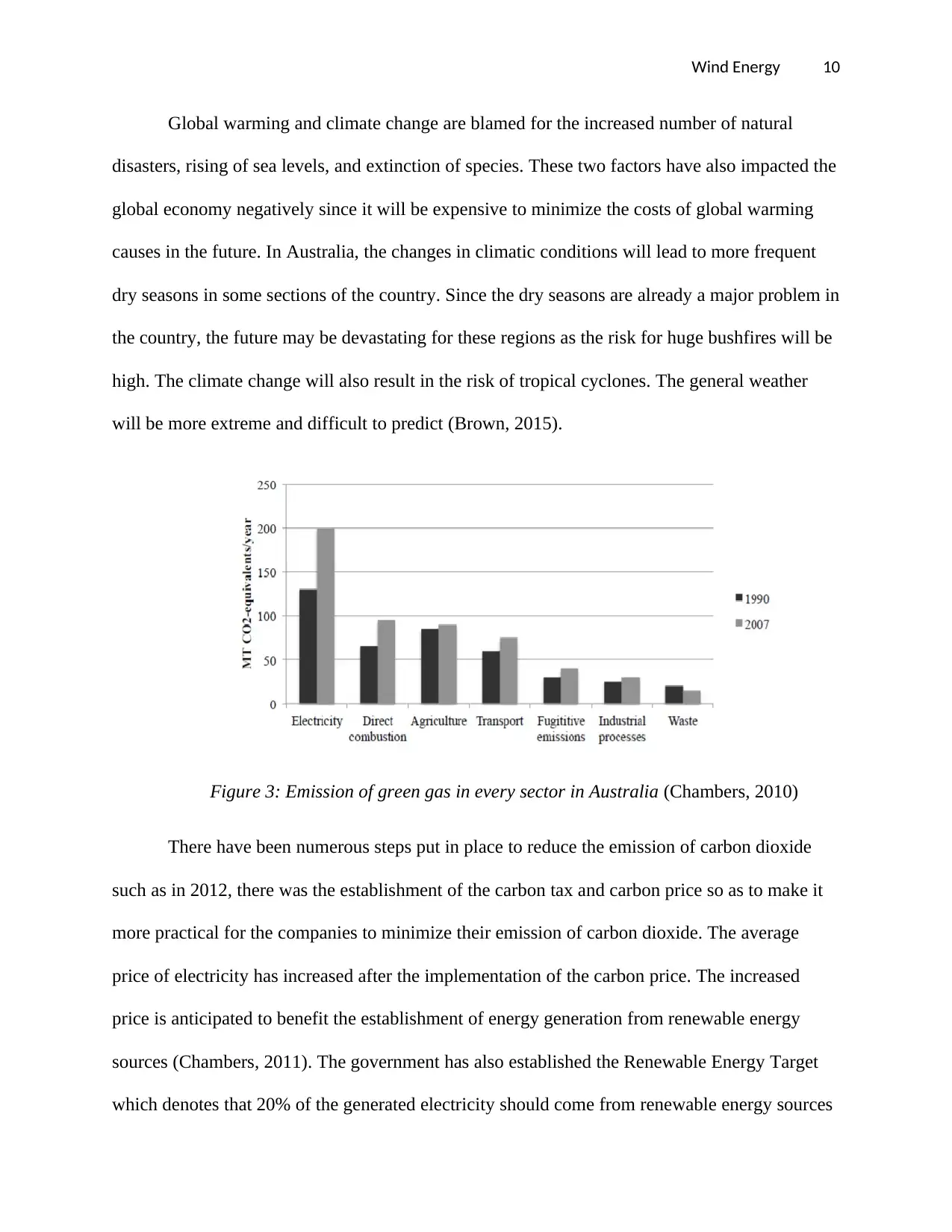
Wind Energy 10
Global warming and climate change are blamed for the increased number of natural
disasters, rising of sea levels, and extinction of species. These two factors have also impacted the
global economy negatively since it will be expensive to minimize the costs of global warming
causes in the future. In Australia, the changes in climatic conditions will lead to more frequent
dry seasons in some sections of the country. Since the dry seasons are already a major problem in
the country, the future may be devastating for these regions as the risk for huge bushfires will be
high. The climate change will also result in the risk of tropical cyclones. The general weather
will be more extreme and difficult to predict (Brown, 2015).
Figure 3: Emission of green gas in every sector in Australia (Chambers, 2010)
There have been numerous steps put in place to reduce the emission of carbon dioxide
such as in 2012, there was the establishment of the carbon tax and carbon price so as to make it
more practical for the companies to minimize their emission of carbon dioxide. The average
price of electricity has increased after the implementation of the carbon price. The increased
price is anticipated to benefit the establishment of energy generation from renewable energy
sources (Chambers, 2011). The government has also established the Renewable Energy Target
which denotes that 20% of the generated electricity should come from renewable energy sources
Global warming and climate change are blamed for the increased number of natural
disasters, rising of sea levels, and extinction of species. These two factors have also impacted the
global economy negatively since it will be expensive to minimize the costs of global warming
causes in the future. In Australia, the changes in climatic conditions will lead to more frequent
dry seasons in some sections of the country. Since the dry seasons are already a major problem in
the country, the future may be devastating for these regions as the risk for huge bushfires will be
high. The climate change will also result in the risk of tropical cyclones. The general weather
will be more extreme and difficult to predict (Brown, 2015).
Figure 3: Emission of green gas in every sector in Australia (Chambers, 2010)
There have been numerous steps put in place to reduce the emission of carbon dioxide
such as in 2012, there was the establishment of the carbon tax and carbon price so as to make it
more practical for the companies to minimize their emission of carbon dioxide. The average
price of electricity has increased after the implementation of the carbon price. The increased
price is anticipated to benefit the establishment of energy generation from renewable energy
sources (Chambers, 2011). The government has also established the Renewable Energy Target
which denotes that 20% of the generated electricity should come from renewable energy sources
Paraphrase This Document
Need a fresh take? Get an instant paraphrase of this document with our AI Paraphraser

Wind Energy 11
by 2020. The aim of this initiative is to speed up the transition towards a cleaner supply of
electricity within the country. The energy sector accounts for a huge part of the total emission of
greenhouse gases in the country and also the emission from the generation of electricity has
continuously increased at a faster rate compared to other sectors in the country as shown in
figure 3 above (Chandra, 2009).
Nonrenewable Energy Sources
The production of electricity has normally been through non-renewable sources from the
past decade. The non-renewable sources are known for their environmental degradation
specifically in terms of melting of glaciers, depletion of ozone layer, or change in the climatic
conditions. There has been depletion of the ozone layer as a result of greenhouse gases in the
atmosphere which is released during the generation of electricity by nonrenewable sources of
energy. There are changes in the climatic condition in the whole world and the prediction of the
environmental condition has always been characterized by inaccuracies (Council, 2009). The
nonrenewable source can be defined as those sources that do not renew themselves as a
satisfactory rate for sustainable economic extraction. Some of the non-renewable sources of
energy in Australia include:
Uranium: Australia has more than a third of the total world economy of uranium resources. The
major deposits of Uranium are in Western Australia, Northern Territory, and South Australia.
The production of Uranium in Australia is majorly for the purposes of exportation.
Crude Oil: The major sources of crude oil in Australia is located in Gippsland and Carnarvon. It
takes numerous years for these resources to form naturally and cannot be replaced after
by 2020. The aim of this initiative is to speed up the transition towards a cleaner supply of
electricity within the country. The energy sector accounts for a huge part of the total emission of
greenhouse gases in the country and also the emission from the generation of electricity has
continuously increased at a faster rate compared to other sectors in the country as shown in
figure 3 above (Chandra, 2009).
Nonrenewable Energy Sources
The production of electricity has normally been through non-renewable sources from the
past decade. The non-renewable sources are known for their environmental degradation
specifically in terms of melting of glaciers, depletion of ozone layer, or change in the climatic
conditions. There has been depletion of the ozone layer as a result of greenhouse gases in the
atmosphere which is released during the generation of electricity by nonrenewable sources of
energy. There are changes in the climatic condition in the whole world and the prediction of the
environmental condition has always been characterized by inaccuracies (Council, 2009). The
nonrenewable source can be defined as those sources that do not renew themselves as a
satisfactory rate for sustainable economic extraction. Some of the non-renewable sources of
energy in Australia include:
Uranium: Australia has more than a third of the total world economy of uranium resources. The
major deposits of Uranium are in Western Australia, Northern Territory, and South Australia.
The production of Uranium in Australia is majorly for the purposes of exportation.
Crude Oil: The major sources of crude oil in Australia is located in Gippsland and Carnarvon. It
takes numerous years for these resources to form naturally and cannot be replaced after
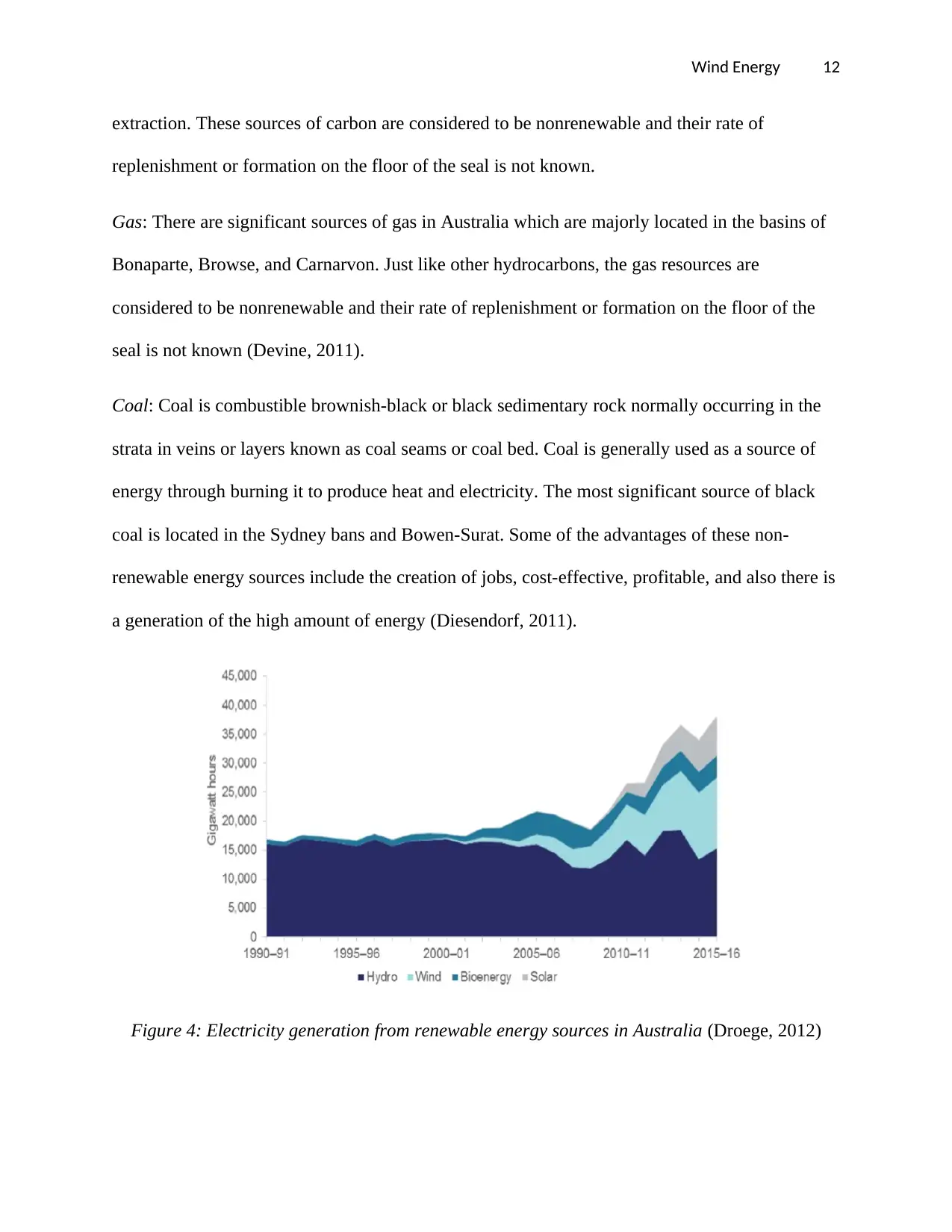
Wind Energy 12
extraction. These sources of carbon are considered to be nonrenewable and their rate of
replenishment or formation on the floor of the seal is not known.
Gas: There are significant sources of gas in Australia which are majorly located in the basins of
Bonaparte, Browse, and Carnarvon. Just like other hydrocarbons, the gas resources are
considered to be nonrenewable and their rate of replenishment or formation on the floor of the
seal is not known (Devine, 2011).
Coal: Coal is combustible brownish-black or black sedimentary rock normally occurring in the
strata in veins or layers known as coal seams or coal bed. Coal is generally used as a source of
energy through burning it to produce heat and electricity. The most significant source of black
coal is located in the Sydney bans and Bowen-Surat. Some of the advantages of these non-
renewable energy sources include the creation of jobs, cost-effective, profitable, and also there is
a generation of the high amount of energy (Diesendorf, 2011).
Figure 4: Electricity generation from renewable energy sources in Australia (Droege, 2012)
extraction. These sources of carbon are considered to be nonrenewable and their rate of
replenishment or formation on the floor of the seal is not known.
Gas: There are significant sources of gas in Australia which are majorly located in the basins of
Bonaparte, Browse, and Carnarvon. Just like other hydrocarbons, the gas resources are
considered to be nonrenewable and their rate of replenishment or formation on the floor of the
seal is not known (Devine, 2011).
Coal: Coal is combustible brownish-black or black sedimentary rock normally occurring in the
strata in veins or layers known as coal seams or coal bed. Coal is generally used as a source of
energy through burning it to produce heat and electricity. The most significant source of black
coal is located in the Sydney bans and Bowen-Surat. Some of the advantages of these non-
renewable energy sources include the creation of jobs, cost-effective, profitable, and also there is
a generation of the high amount of energy (Diesendorf, 2011).
Figure 4: Electricity generation from renewable energy sources in Australia (Droege, 2012)
⊘ This is a preview!⊘
Do you want full access?
Subscribe today to unlock all pages.

Trusted by 1+ million students worldwide
1 out of 40
Related Documents
Your All-in-One AI-Powered Toolkit for Academic Success.
+13062052269
info@desklib.com
Available 24*7 on WhatsApp / Email
![[object Object]](/_next/static/media/star-bottom.7253800d.svg)
Unlock your academic potential
Copyright © 2020–2025 A2Z Services. All Rights Reserved. Developed and managed by ZUCOL.





